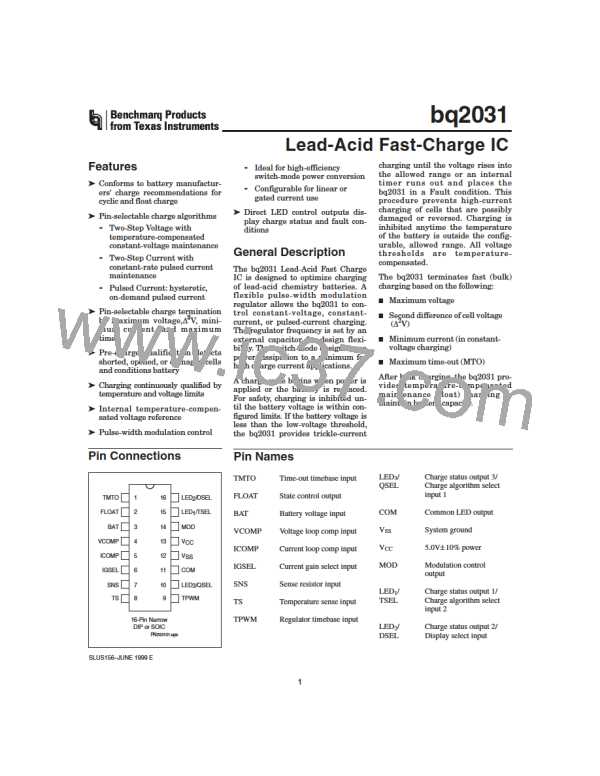bq2031
Second Difference (∆2V)
V
CC
Second difference is a Unitrode proprietary algorithm
that accumulates the difference between successive sam-
ples of VBAT. The bq2031 takes a sample and makes a
R
C
1
termination decision at a frequency equal to 0.008
TM
*
t
MTO. Fast charge terminates when the accumulated dif-
ference is ≤ -8mV. Second difference is used only in the
Two-Step Current algorithm, and is subject to a hold-off
period (see below).
13
12
V
CC
V
SS
Maximum Voltage
Fast charge terminates when VCELL ≥ VBLK. VBLK is set
per equation 2. Maximum voltage is used for fast charge
termination in the Two-Step Current and Pulsed Cur-
rent algorithms, and for transition from phase 1 to
phase 2 in the Two-Step Voltage algorithm. This crite-
rion is subject to a hold-off period.
bq2031
V
SS
FG203112.eps
Hold-off Periods
Maximum V and ∆2V termination criteria are subject
Figure 9. R-C Network for Setting MTO
to a hold-off period at the start of fast charge equal to
0.15
tMTO. During this time, these termination criteria
*
Maintenance Charging
are ignored.
Three algorithms are used in maintenance charging:
Maximum Time-Out
n
n
n
Two-Step Voltage algorithm
Two-Step Current algorithm
Pulsed Current algorithm
Fast charge terminates if the programmed MTO time is
reached without some other termination shutting off
fast charge. MTO is programmed from 1 to 24 hours by
an R-C network on TMTO (see Figure 9) per the equa-
tion:
Two-Step Voltage Algorithm
Equation 6
In the Two-Step Voltage algorithm, the bq2031 provides
charge maintenance by regulating charging voltage to
t
MTO = 0.5
R
C
*
*
V
FLT. Charge current during maintenance is limited to
where R is in kΩ, C is in µF, and tMTO is in hours. Typi-
cally, the maximum value for C of 0.1µF is used.
ICOND
.
Two-Step Current Algorithm
Fast-charge termination by MTO is a Fault only in the
Pulsed Current algorithm; the bq2031 enters the Fault
state and waits for a new battery insertion, at which
time it begins a new charge cycle. In the Two-Step Volt-
age and Two-Step Current algorithms, the bq2031 tran-
sitions to the maintenance phase on MTO time-out.
Maintenance charging in the Two-Step Current Algo-
rithm is implemented by varying the period (TP) of a
fixed current (ICOND = IMAX/5) and duration (0.2 sec-
onds) pulse to achieve the configured average mainte-
nance current value. See Figure 10.
The MTO timer starts at the beginning of fast charge. In
the Two-Step Voltage algorithm, it is cleared and re-
started when the bq2031 transitions from phase 1 (cur-
rent regulation) to phase 2 (voltage regulation). The
MTO timer is suspended (but not reset) during the out-
of-range temperature (Charge Pending) state.
Maintenance current can be calculated by:
Equation 7
((0.2) ∗ ICOND
)
((0.04) ∗ IMAX )
Maintenance current =
=
TP
TP
where TP is the period of the waveform in seconds.
Table 4 gives the values of P programmed by IGSEL.
9

 TI [ TEXAS INSTRUMENTS ]
TI [ TEXAS INSTRUMENTS ]